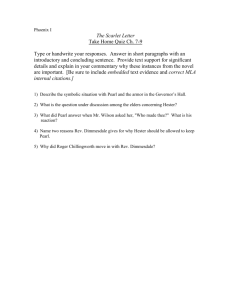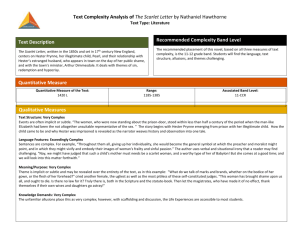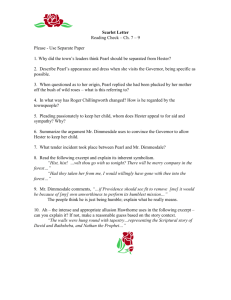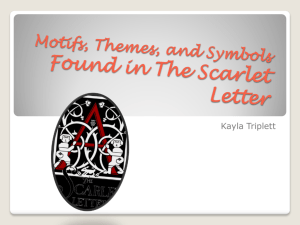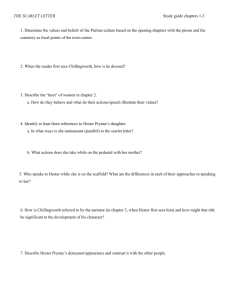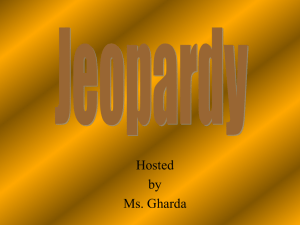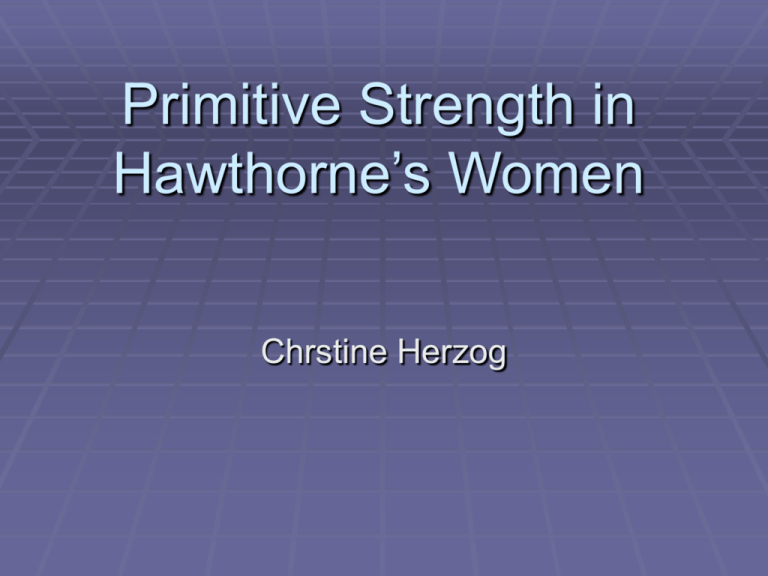
Primitive Strength in
Hawthorne’s Women
Chrstine Herzog
A Reminder
No need to give chapter title if you are
citing a book written by one single author
Background Information
The western cultural tradition of binary
opposition and its implied hierarchy
The feminists’ critique/ subversion of such
opposition
a) negating biological determinism
b) Replacing hierarchy with difference
c) laying bare the effect wrought by
cultural construction
d) performance theory
The Central Idea
The opposition between women and men in
Hawthorne’s works
Thesis Statement (Reversing Value
Hierarchy in Traditional Binary Opposition)
The primitive vitality of many of
Hawthorne’s women is frequently
symbolized by their association with
Oriental, Mediterranean, Indian or other
exotic elements, but it is also portrayed
indirectly by contrasting the women with
idealistic, Faustian, science-possessed
men who wield unnatural power over them
and reject woman’s earthiness.
General Outline:
Illustration by Various Works
I. “The New Adam and Eve”
II. “The Birth Mark” and “Rappaccini’s
Daughter”
III. The Scarlet Letter
I. “The New Adam and Eve”
1. Intellectualism is related to sin and decay:
2. The distinctive nature of man and woman
1) man: intellect
2) woman: nature, tenderness and moral
sense
II. “The Birth Mark” and “Rappaccini’s
Daughter”
1. Male Characters:
1) Aylmer and Rappaccini
---A) striving for ultimate control over nature
---B) scientific deviltry
2) The other male characters
---A) Baglione’s jealous hatred
---B) Giovanni’s poisonous mistrust
---C) Aminadab: the savagery under the
guise of science
II. “The Birth Mark” and “Rappaccini’s
Daughter”
2. Female Characters and their characteristics
1) Georgiana:
---A) birth mark as a symbol of life-force
---B) the stronger person when facing death
---C) Georgiana as an Eve of Power: open
and frank
2) Beatrice: with more complex power
---A) love and trust: fountain vs. artificial
shrub
---B) the warm integrity of Beatrice
II. “The Birth Mark” and “Rappaccini’s
Daughter”
3. The contrast between women and men
1) heart vs. brain
2) instinctual, primitive forces (women’s
life-giving forces) vs. Faustian
intellectual
III. The Scarlet Letter:
Aboriginal and Awesome
1. Hester as a symbol of the Other that threatens
the Puritan community
1) Hester’s emergence from the prison
2) The primitive forest
3) Pearl
2. Ambivalence: the image of Divine Maternity as a
contrast to the threatening Other
3. Conclusion: Romantic primitivism tampered by
suffering and faith
1) Hester’s emergence from the
prison
A. Wildness and passion in Hester’s
character:
a) the aboriginal
b) the alien/ exotic
c) rich, voluptuous—the Oriental
2) The primitive forest
A.
B.
C.
D.
E.
F.
Moral wilderness
Outlaw existence
Impulsive and passionate
Natural dignity
Combative energy
Never subjugated by human law
3) Pearl: The Most Splendid Image
for Hester’s nature
A. The “demon-offspring” in Puritans’ eyes
B. Combining native audacity with the
reserve
C. Part of nature: April breeze, brook
nymph-child
D. Pearl’s garment: looking as exotic as “a
wild tropical bird”
2. The image of Divine Maternity
1) The flood of sunshine in the forest:
redeeming and healing love
2) Pearl: image of love and liberation
3) Hester:
---A. a Mary figure, divine mother, sister of
Mercy, nun, saint, angel prophetess,
martyr
---B. The letter A: adulteress, angel of mercy
3.Conclusion: Romantic primitivism
tampered by suffering and faith
1. The Central symbol: the scaffold
1) shame vs. elevation
2) human vs. divine law
2. Hester as a White Indian
1) knowledge vs. sexual power
2) awesome power of commitment vs.
aboriginal freedom
3) an example of new American Eve: she
builds community instead of destroying it

